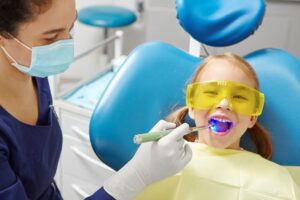
Today, when you think of a pediatric dentist, you imagine a specialist dentist that’s amazing with kids. What you don’t think about is that the overarching profession of dentistry goes back countless centuries, with pediatric dentists only first entering the scene in the 1900s. Read on to learn about how the education, standards, and knowledge of growing smiles has changed throughout the years, and when pediatric dentists were first introduced to the field of dentistry.
The Building Blocks of Pediatric Dentistry
Pediatric dentists arose out of a passionate group of dental professionals interested in caring for and debunking the mystery surrounding children’s smiles. American dentist Alfred C. Jones started the Fones Clinic for Dental Hygienists in Bridgeport, Connecticut (which is still there today!) to teach women how to clean school children’s teeth. At the same time this children’s dental health-centered school was opened, a dental assistant named Minnie Evangeline Jordon began her own dental practice, where she only saw children, in Los Angeles, California. It was a first of its kind!
These ideas of specializing in taking care of growing smiles would later become known as the building blocks of pediatric dentistry, as they led to research on how certain foods and sugars impact children’s teeth. Ultimately, based on this research, dentists, hygienists, and dental assistants began delving deeper into the unique needs of growing smiles, realizing the modern vision of pediatric dentistry.
What Training Do Modern Pediatric Dentists Have?
Pediatric dentists today solely see children between the ages of infancy to 18 years old. This is because the jaw and mouth stop developing around 18, and their specialty knowledge is centered around this oral growth period.
Unlike regular dentists who attend dental school and then go out into the world to practice, pediatric dentists take their education and training one step farther. After four years of dental school, they attend an additional two year residency program where they focus on treating infants, children, teens, and children with special needs.
This additional education and hands-on training provides them with unique insight into the development of children’s facial anatomy, allowing them to spot and treat the early signs of concerns before they have an opportunity to progress.
What Types of Treatments Do Modern Pediatric Dentists Provide?
Today, pediatric dentists do more than just clean teeth! They offer a wide range of services focused on the prevention, restoration, and emergency care of children. Some of the treatments they provide include:
- Evaluations for orthodontics
- Brushing and flossing habits
- Thumb and pacifier-sucking education
- Dental checkups and cleanings
- Fluoride treatment
- Airway and sleep evaluations
- Nerve treatments
- And so much more!
Many parents opt for the trained eye of a pediatric dentist to look after their child’s oral health because of how kid-friendly their offices are, as well as how much knowledge and insight they bring to the table. Over the decades, pediatric dentistry has come a long way, but understanding just how much additional training, education, and overall advancements have been made in this field allows you to choose the best provider for your family’s most precious smile.
About the Practice
At Brush Pediatric Dentistry, our team is led by six experienced and knowledgeable pediatric dentists. As moms and specialists in their field, each of our specialists is committed to providing attentive, personalized, and educational care that prioritizes growing smiles. With a commitment to parent collaboration, our team knows exactly what it means to offer compassionate, outstanding care. For questions or to schedule an appointment, visit Brush Pediatric Dentistry’s website or call 630-504-2223.
